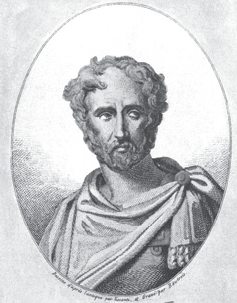When the Italian volcano Mount Vesuvius started spewing rock and ash on August 24, AD 79, terrified residents of nearby towns desperately tried to flee to safer ground. One man, however, traveled in the opposite direction. Instead of fleeing, the writer Pliny the Elder (c. 23–79) decided that he wanted a closer look at the catastrophic eruption.

Pliny, a high-ranking Roman military leader, had published his most famous work, a thirty-seven-volume encyclopedia titled Historia Naturalis, two years earlier. With topics ranging from wine making to mining, medicine to geography, the book contained as much of the ancient world’s knowledge as Pliny could gather. But it had no chapter on volcanoes, and the massive eruption piqued his curiosity.
Pliny, whose full name was Gaius Plinius Secundus, was born into the equestrian class, one of the noble ranks of ancient Rome. He served in the Roman legions during wars against the Germanic tribes and the Britons and wrote a history of the war, now lost, after returning to Rome.
He was promoted to the position of procurator under the emperor Vespasian (AD 9–79). Insatiably curious, he traveled through modern-day Spain and France, taking notes on the wineries, gold mines, and mountain ranges he visited. Pliny spent much of the 70s writing the encyclopedia, which was dedicated to the emperor upon its completion in 77 and remained a standard reference work for centuries. A grateful Vespasian then put Pliny in charge of the Roman navy, the position he held on the day of the fateful eruption.
As the volcano continued to rumble, Pliny sailed across the Bay of Naples, hoping to observe the huge mushroom cloud of smoke over the crater and perhaps rescue survivors from the city of Pompeii. The city was virtually destroyed by the ash and rock that rained down during the eighteen-hour eruption.
However, after landing, Pliny’s crew was overcome by the pumice, cinders, and sulfurous gases pouring out of the volcano. He died in a field the next morning, possibly from the fumes or from a heart attack.
ADDITIONAL FACTS
- The type of eruption observed at Vesuvius in 79—a huge column of smoke rising above the volcano’s crater—is still called a Plinian eruption in honor of the mountain’s most famous victim.
- Pliny’s nephew, Gaius Plinius Caecilius Secundus (c. 61–c. 113), was also a prominent writer and statesman. He is usually known as Pliny the Younger to distinguish him from his uncle.
- The encyclopedia contained thousands of supposed medical cures derived from plants and animals. For instance, in one section Pliny wrote that the skin of a freshly killed goat could be used to treat snakebites.
